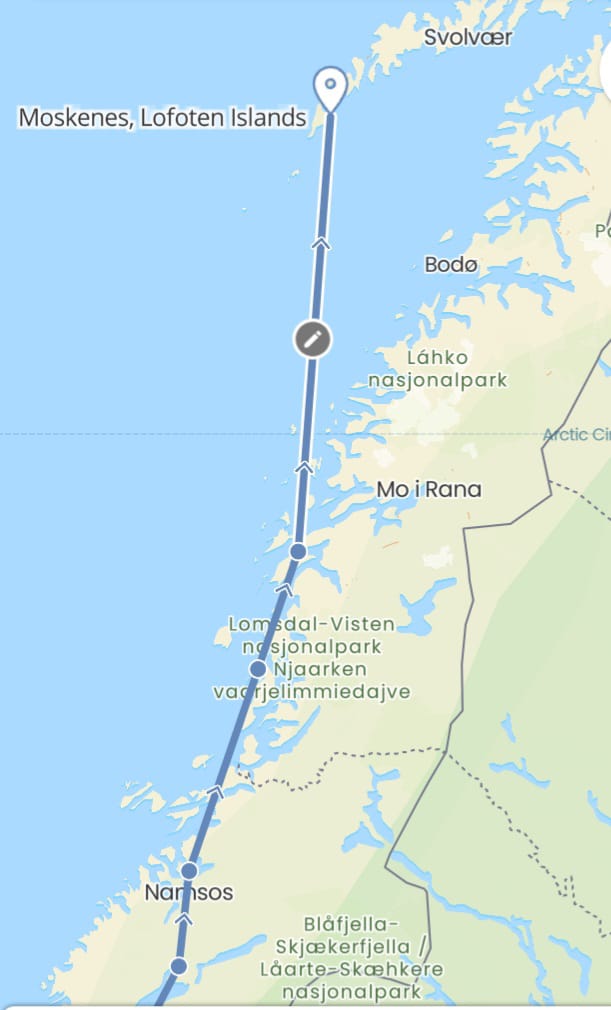Days 20 & 21: Helgeland Bridge to Nesna (38 kms) and Nesna to Moskenes, Lofoten Islands (est 200 kms by ferry)
- Tim Bugler
- Jul 22
- 4 min read
Neither my legs nor Claud's tyres have seen much action the last two days, not indeed has much of huge cultural significance passed my eyes and ears, so perhaps I should take my wife's advice, in this as in all things, and keep it short.
Leaving our overnight wildcamp between the two concrete picnic tables beside the trunk road (not really “in the wild” come to think of it, we hot-pedalled it to catch the ferry at Levang for Nesna on the other side of the next fjord. Half a mile away we met a procession of cars coming towards us and I began to suspect strongly we were too late. A Latvian articulated lorry raced past us, but as we rounded the final bend I saw the vessel easing away from the ramp, lowering its bow visor. Next I saw the Latvian lorry driver get out of his cab with a fishing rod and walk off round the headland, and I knew we were in for a bit of a wait. An hour and three-quarters in fact, because I'd hit another refuelling break (diesel this time). The Frenchman and his collie – whom I'd last seen two days earlier with a broken spoke – caught up with me at this point. He told me the bike shop in Namsos had the exact wheel he needed in stock, and he'd been back on the road within a couple of hours – which I think he'd been pretty lucky about, given how far he could have been from help in this big country. Still waiting, I fell into conversation with a Norwegian couple of about my age, and their daughter. The thoughts of a lot of cyclists I meet -- now that we're all two or three weeks away from Nordkapp, the destination for many of us --- are turning to how to get home again. It's quite complex, and very difficult to work out in advance, sitting at home in Scotland, or the Netherlands, or wherever, when, for example, the difference between a ferjekair (ferry landing) and a hurtibatskai (express boat quay) and a kystrutekai (coastal steamer quay) are still unclear. The Norwegian couple told me not to rely on the railway – which anyway only goes as far north as Bodo. An accident to one of the trains in the winter meant half the rolling stock on the line was still out of action and they were down to one day train and one night train every 24 hours, they said. “No-one care about us in Oslo,” they added. “Down there they have a train every 15 minutes but they don't care about us up north.” I told them we had a familiar feeling in Scotland. Another French cyclist told me he'd tried to book a bike on the Bodo train, but was told there were no bike spaces. Again, a familiar refrain. He said he intended to get round it by bribing the guard. I told him I doubted that would be successful but I had found being very polite and looking crestfallen sometimes did.
When we did leave, the crossing to the yacht haven of Nesna was a mere 23 minutes, but I then multiplied this manyfold by leaving my UK plug adaptor on the ferry and having to await its return to recover it. Snatching a quick charge of my devices during ferry crossings has become routine. So has leaving behind the adaptor, unfortunately. Looking at my options, I saw that the next leg of the EV1 was one I'd dearly like to avoid. There was a lot of climb, two fjords to cycle round – I have begun to find it faintly trying spending two hours cycling just to end up a kilometre across the water from where I started – and five tunnels. One of these was described in the EuroVelo 1 guide I'm using as “a 3.7 km long, poorly lit tube, with ventilation that leaves much to be desired”. It turned out there was an alternative – an express boat was leaving the next morning at 6.55 am which would whisk me past all of that for £16 (pensioners' rate). I checked into a campsite by the quay, where I was entertained by the crew of a powerboat (British, I fear) singing, carousing and playing music at full volume until 2.00 am. Oh for the peace and quiet of a trunk road layby.
The next day we were indeed whisked at speed – 40 kph most of the time -- to Bodo, Norway's southernmost seaport in the Arctic Circle, where we rejoined the EV 1 cycle route which at this point itself gets sealegs, via the much slower State-run car ferry from Bodo to the Lofoten Islands, 31 miles off the Norwegian mainland. I learn that wild camping is often “discouraged” on the Lofotens, so I'm pitched for the night at the pleasant but frantically-busy Moskenes Camping Ground looking forward to what I suspect will be another highlight of the trip.
The trip from Bodo to the Lofoten Islands takes four hours on the ferry, by the way. Norway is still in the throes of its heatwave, so I spent much of it sleeping on a bench on the sundeck. However I noted with interest that a surprisingly large number of young Norwegian women spent it knitting.
Waiting for the ferry on Bodo Quay




Just an idea re getting home Tim - and probably one that's too convoluted - but if you can get yourself back to Narvik after Nordkapp there's a train that goes Narvik - Riksgransen - Kiruna - Stockholm from where you could fly back to Scotland.
I travelled on it about three years ago - it's a long journey but it may work for you